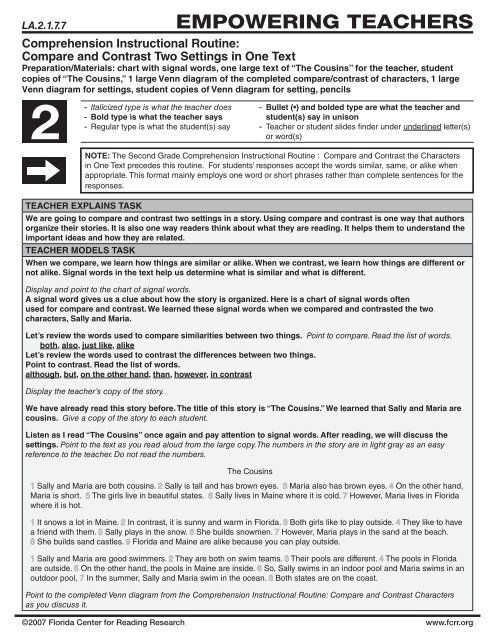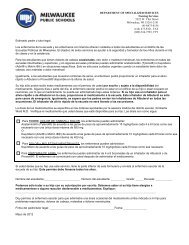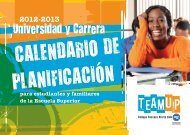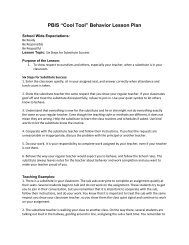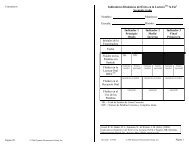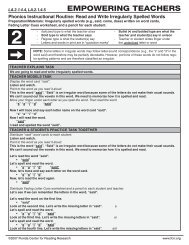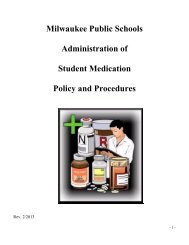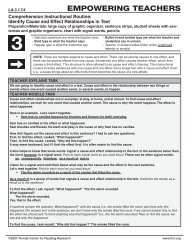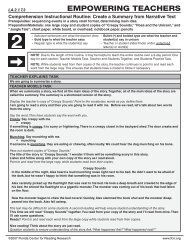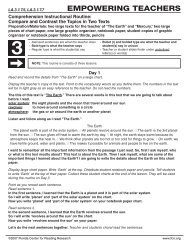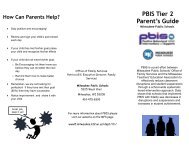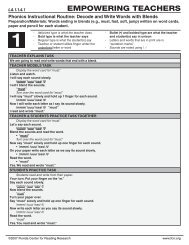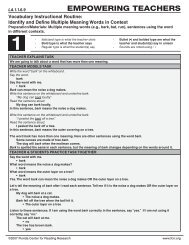Compare and Contrast Two Settings in
Compare and Contrast Two Settings in
Compare and Contrast Two Settings in
You also want an ePaper? Increase the reach of your titles
YUMPU automatically turns print PDFs into web optimized ePapers that Google loves.
LA.2.1.7.7<br />
EMPOWERING TEACHERS<br />
Comprehension Instructional Rout<strong>in</strong>e:<br />
<strong>Compare</strong> <strong>and</strong> <strong>Contrast</strong> <strong>Two</strong> <strong>Sett<strong>in</strong>gs</strong> <strong>in</strong> One Text<br />
Preparation/Materials: chart with signal words, one large text of “The Cous<strong>in</strong>s” for the teacher, student<br />
copies of “The Cous<strong>in</strong>s,” 1 large Venn diagram of the completed compare/contrast of characters, 1 large<br />
Venn diagram for sett<strong>in</strong>gs, student copies of Venn diagram for sett<strong>in</strong>g, pencils<br />
2<br />
-<br />
-<br />
-<br />
TEACHER EXPLAINS TASK<br />
We are go<strong>in</strong>g to compare <strong>and</strong> contrast two sett<strong>in</strong>gs <strong>in</strong> a story. Us<strong>in</strong>g compare <strong>and</strong> contrast is one way that authors<br />
organize their stories. It is also one way readers th<strong>in</strong>k about what they are read<strong>in</strong>g. It helps them to underst<strong>and</strong> the<br />
important ideas <strong>and</strong> how they are related.<br />
TEACHER MODELS TASK<br />
Italicized type is what the teacher does<br />
Bold type is what the teacher says<br />
Regular type is what the student(s) say<br />
When we compare, we learn how th<strong>in</strong>gs are similar or alike. When we contrast, we learn how th<strong>in</strong>gs are different or<br />
not alike. Signal words <strong>in</strong> the text help us determ<strong>in</strong>e what is similar <strong>and</strong> what is different.<br />
Display <strong>and</strong> po<strong>in</strong>t to the chart of signal words.<br />
A signal word gives us a clue about how the story is organized. Here is a chart of signal words often<br />
used for compare <strong>and</strong> contrast. We learned these signal words when we compared <strong>and</strong> contrasted the two<br />
characters, Sally <strong>and</strong> Maria.<br />
Let’s review the words used to compare similarities between two th<strong>in</strong>gs. Po<strong>in</strong>t to compare. Read the list of words.<br />
both, also, just like, alike<br />
Let’s review the words used to contrast the differences between two th<strong>in</strong>gs.<br />
Po<strong>in</strong>t to contrast. Read the list of words.<br />
although, but, on the other h<strong>and</strong>, than, however, <strong>in</strong> contrast<br />
Display the teacher’s copy of the story.<br />
We have already read this story before. The title of this story is “The Cous<strong>in</strong>s.” We learned that Sally <strong>and</strong> Maria are<br />
cous<strong>in</strong>s. Give a copy of the story to each student.<br />
Listen as I read “The Cous<strong>in</strong>s” once aga<strong>in</strong> <strong>and</strong> pay attention to signal words. After read<strong>in</strong>g, we will discuss the<br />
sett<strong>in</strong>gs. Po<strong>in</strong>t to the text as you read aloud from the large copy. The numbers <strong>in</strong> the story are <strong>in</strong> light gray as an easy<br />
reference to the teacher. Do not read the numbers.<br />
The Cous<strong>in</strong>s<br />
Sally <strong>and</strong> Maria are both cous<strong>in</strong>s. Sally is tall <strong>and</strong> has brown eyes. Maria also has brown eyes. On the other h<strong>and</strong>,<br />
Maria is short. The girls live <strong>in</strong> beautiful states. Sally lives <strong>in</strong> Ma<strong>in</strong>e where it is cold. However, Maria lives <strong>in</strong> Florida<br />
where it is hot.<br />
It snows a lot <strong>in</strong> Ma<strong>in</strong>e. In contrast, it is sunny <strong>and</strong> warm <strong>in</strong> Florida. Both girls like to play outside. They like to have<br />
a friend with them. Sally plays <strong>in</strong> the snow. She builds snowmen. However, Maria plays <strong>in</strong> the s<strong>and</strong> at the beach.<br />
She builds s<strong>and</strong> castles. Florida <strong>and</strong> Ma<strong>in</strong>e are alike because you can play outside.<br />
Sally <strong>and</strong> Maria are good swimmers. They are both on swim teams. Their pools are different. The pools <strong>in</strong> Florida<br />
are outside. On the other h<strong>and</strong>, the pools <strong>in</strong> Ma<strong>in</strong>e are <strong>in</strong>side. So, Sally swims <strong>in</strong> an <strong>in</strong>door pool <strong>and</strong> Maria swims <strong>in</strong> an<br />
outdoor pool, In the summer, Sally <strong>and</strong> Maria swim <strong>in</strong> the ocean. Both states are on the coast.<br />
Po<strong>in</strong>t to the completed Venn diagram from the Comprehension Instructional Rout<strong>in</strong>e: <strong>Compare</strong> <strong>and</strong> <strong>Contrast</strong> Characters<br />
as you discuss it.<br />
©2007 Florida Center for Read<strong>in</strong>g Research www.fcrr.org<br />
-<br />
-<br />
Bullet (•) <strong>and</strong> bolded type are what the teacher <strong>and</strong><br />
student(s) say <strong>in</strong> unison<br />
Teacher or student slides f<strong>in</strong>der under underl<strong>in</strong>ed letter(s)<br />
or word(s)<br />
NOTE: The Second Grade Comprehension Instructional Rout<strong>in</strong>e : <strong>Compare</strong> <strong>and</strong> <strong>Contrast</strong> the Characters<br />
<strong>in</strong> One Text precedes this rout<strong>in</strong>e. For students’ responses accept the words similar, same, or alike when<br />
appropriate. This format ma<strong>in</strong>ly employs one word or short phrases rather than complete sentences for the<br />
responses.
TEACHER MODELS TASK (cont<strong>in</strong>ued)<br />
EMPOWERING TEACHERS<br />
We used this Venn diagram to compare <strong>and</strong> contrast the characters Sally <strong>and</strong> Maria. We can also use a Venn<br />
diagram to compare <strong>and</strong> contrast sett<strong>in</strong>gs. This story has two sett<strong>in</strong>gs, Ma<strong>in</strong>e <strong>and</strong> Florida. We are go<strong>in</strong>g to<br />
compare <strong>and</strong> contrast Ma<strong>in</strong>e <strong>and</strong> Florida us<strong>in</strong>g another Venn diagram. It will help us see how they are similar or<br />
alike <strong>and</strong> how they are different or not alike.<br />
Display second Venn diagram <strong>and</strong> po<strong>in</strong>t to the sections as they are mentioned.<br />
Remember, a Venn diagram consists of two circles that overlap.<br />
This circle represents Ma<strong>in</strong>e (write Ma<strong>in</strong>e at the top of one circle) <strong>and</strong> this circle represents Florida (write Florida at<br />
the top of the other circle). When I f<strong>in</strong>d differences between the two states, I will write all that is true about Ma<strong>in</strong>e <strong>in</strong><br />
this space (po<strong>in</strong>t to empty space below Ma<strong>in</strong>e) <strong>and</strong> all that is true about Florida <strong>in</strong> this space (po<strong>in</strong>t to empty space<br />
below Florida).<br />
The place where the circles overlap represents their similarities or how they are alike. So I will write everyth<strong>in</strong>g<br />
that is similar about Ma<strong>in</strong>e <strong>and</strong> Florida <strong>in</strong> this space.<br />
Listen <strong>and</strong> follow along as I reread the first paragraph. Pay attention to signal words for clues to compar<strong>in</strong>g <strong>and</strong><br />
contrast<strong>in</strong>g.<br />
Po<strong>in</strong>t to each word as you read aloud from the large copy of the story.<br />
Sally <strong>and</strong> Maria are both cous<strong>in</strong>s. Sally is tall <strong>and</strong> has brown eyes. Maria also has brown eyes. On the other<br />
h<strong>and</strong>, Maria is short. The girls live <strong>in</strong> beautiful states. Sally lives <strong>in</strong> Ma<strong>in</strong>e where it is cold. However, Maria lives <strong>in</strong><br />
Florida where it is hot.<br />
Now, I need to reread each sentence <strong>and</strong> look for signal words to help me f<strong>in</strong>d out what is similar <strong>and</strong> what is<br />
different about Ma<strong>in</strong>e <strong>and</strong> Florida.<br />
Reread each sentence <strong>and</strong> po<strong>in</strong>t to the words. Always po<strong>in</strong>t to the chart when discuss<strong>in</strong>g all signal words.<br />
Read sentence 1 <strong>in</strong> paragraph 1.<br />
This sentence does not tell me about Ma<strong>in</strong>e or Florida. I need to read more to f<strong>in</strong>d out how they are similar or<br />
different.<br />
Read sentence 2-4.<br />
These sentences do not tell me about Ma<strong>in</strong>e or Florida either. So far, the sentences are about Sally <strong>and</strong> Maria. I’ll<br />
read on.<br />
Read sentence 5.<br />
There is no signal word <strong>in</strong> this sentence, but it tells me that there are two th<strong>in</strong>gs that are similar about Ma<strong>in</strong>e<br />
<strong>and</strong> Florida. They are beautiful <strong>and</strong> they are states. I want to show how Ma<strong>in</strong>e <strong>and</strong> Florida are alike on the Venn<br />
diagram. I will write ‘beautiful’ <strong>and</strong> ‘states’ <strong>in</strong> the overlapp<strong>in</strong>g circles. Remember, there is not always a signal word<br />
to rem<strong>in</strong>d us of similarities <strong>and</strong> differences.<br />
Read sentences 6 & 7.<br />
These sentences tell me about Ma<strong>in</strong>e <strong>and</strong> Florida. Isn’t however a signal word? I’m go<strong>in</strong>g to look at the chart of<br />
signal words. Here it is. ‘However’ is a contrast word. It tells me someth<strong>in</strong>g is different between Ma<strong>in</strong>e <strong>and</strong> Florida.<br />
The difference is that it is cold <strong>in</strong> Ma<strong>in</strong>e <strong>and</strong> hot it Florida. So I write ‘cold’ <strong>in</strong> Ma<strong>in</strong>e’s circle <strong>and</strong> ‘hot’ <strong>in</strong> Florida’s<br />
circle.<br />
Now I will look at the Venn diagram to compare <strong>and</strong> contrast Ma<strong>in</strong>e <strong>and</strong> Florida. Po<strong>in</strong>t to each part of the Venn diagram<br />
as you compare <strong>and</strong> contrast.<br />
The overlapp<strong>in</strong>g circles tell me how Ma<strong>in</strong>e <strong>and</strong> Florida are similar. They are both states <strong>and</strong> they are beautiful.<br />
The rest of each circle tells me how Ma<strong>in</strong>e <strong>and</strong> Florida are different.<br />
Ma<strong>in</strong>e is cold. However, Florida is hot.<br />
I can summarize what we’ve learned about the two sett<strong>in</strong>gs by us<strong>in</strong>g signal words <strong>and</strong> the Venn diagram as a guide.<br />
To summarize, I would say this:<br />
Ma<strong>in</strong>e <strong>and</strong> Florida are beautiful states. It is cold <strong>in</strong> Ma<strong>in</strong>e. However, it is hot <strong>in</strong> Florida.<br />
©2007 Florida Center for Read<strong>in</strong>g Research www.fcrr.org
TEACHER AND STUDENTS PRACTICE TASK<br />
EMPOWERING TEACHERS<br />
Remember, when we compare, we learn how th<strong>in</strong>gs are similar or alike. What do we learn when we compare?<br />
• We learn how th<strong>in</strong>gs are similar or alike.<br />
When we contrast, we learn how th<strong>in</strong>gs are different or not alike.<br />
What do we learn when we contrast?<br />
• We learn how th<strong>in</strong>gs are different or not alike.<br />
Signal words can give us clues about similarities <strong>and</strong> differences.<br />
Display <strong>and</strong> po<strong>in</strong>t to the chart of signal words.<br />
Let’s read the signal words used to compare.<br />
• both, also, just like, alike<br />
Let’s read the signal words used to contrast.<br />
• although, but, on the other h<strong>and</strong>, however, than, <strong>in</strong> contrast<br />
Display the teacher’s copy of the story. Po<strong>in</strong>t to each word as you read aloud from the large copy of the story.<br />
Listen <strong>and</strong> follow along as I read the second paragraph of “The Cous<strong>in</strong>s.” Then we will use the Venn diagram to<br />
compare <strong>and</strong> contrast Ma<strong>in</strong>e <strong>and</strong> Florida.<br />
1 It snows a lot <strong>in</strong> Ma<strong>in</strong>e. 2 In contrast, it is sunny <strong>and</strong> warm <strong>in</strong> Florida. 3 Both girls like to play outside. 4 They like to have<br />
a friend with them. 5 Sally plays <strong>in</strong> the snow. 6 She builds snowmen. 7 However, Maria plays <strong>in</strong> the s<strong>and</strong> at the beach. 8<br />
She builds s<strong>and</strong> castles. 9 Florida <strong>and</strong> Ma<strong>in</strong>e are alike because you can play outside.<br />
Give students a copy of the Venn diagram <strong>and</strong> a pencil. Cont<strong>in</strong>ue to display the large Venn diagram <strong>and</strong> po<strong>in</strong>t to the<br />
sections as they are mentioned.<br />
Remember, the overlapp<strong>in</strong>g circles tell us how Ma<strong>in</strong>e <strong>and</strong> Florida are similar or alike.<br />
What do the overlapp<strong>in</strong>g circles tell us?<br />
• They tell us how Ma<strong>in</strong>e <strong>and</strong> Florida are similar or alike.<br />
The rest of each circle tells us how Ma<strong>in</strong>e <strong>and</strong> Florida are different or not alike. What does the rest of each circle tell<br />
us?<br />
• Each circle tells how Ma<strong>in</strong>e <strong>and</strong> Florida are different or not alike.<br />
Now, we will reread each sentence <strong>and</strong> look for signal words to help us f<strong>in</strong>d what is similar <strong>and</strong> what is different<br />
about Ma<strong>in</strong>e <strong>and</strong> Florida.<br />
Read each sentence with students <strong>and</strong> po<strong>in</strong>t to the chart when discuss<strong>in</strong>g all signal words. Teacher fills <strong>in</strong> the large Venn<br />
diagram <strong>and</strong> students fill <strong>in</strong> their own copies of the Venn diagram.<br />
Read sentence 1 <strong>in</strong> paragraph 2.<br />
Does this sentence tell us about Ma<strong>in</strong>e or Florida?<br />
• Yes, it tells us about Ma<strong>in</strong>e.<br />
What does it tell us about Ma<strong>in</strong>e?<br />
• It snows a lot <strong>in</strong> Ma<strong>in</strong>e.<br />
Yes, we know that it snows a lot <strong>in</strong> Ma<strong>in</strong>e. I’ll read on to f<strong>in</strong>d out if there are any similarities or differences about<br />
Florida.<br />
Read sentence 2.<br />
Does this sentence tell us about Ma<strong>in</strong>e or Florida?<br />
• Yes, it tells us about Florida.<br />
I saw the words ‘<strong>in</strong> contrast’ <strong>in</strong> the sentence. Aren’t the words ‘<strong>in</strong> contrast’ signal words? Look at the chart <strong>and</strong> f<strong>in</strong>d<br />
‘<strong>in</strong> contrast’. Is it a compare word or a contrast word?<br />
• a contrast word<br />
Yes. ‘In contrast’ tells us there is a difference between Ma<strong>in</strong>e <strong>and</strong> Florida.<br />
This sentence tells us it is usually sunny <strong>and</strong> warm <strong>in</strong> Florida.<br />
What happens <strong>in</strong> Florida?<br />
• It is usually sunny <strong>and</strong> warm <strong>in</strong> Florida.<br />
What happens <strong>in</strong> Ma<strong>in</strong>e?<br />
• It snows a lot <strong>in</strong> Ma<strong>in</strong>e.<br />
Yes. It was a good th<strong>in</strong>g we read more than one sentence because we learned the differences. It is usually sunny<br />
<strong>and</strong> warm <strong>in</strong> Florida. In contrast, it snows a lot <strong>in</strong> Ma<strong>in</strong>e.<br />
To show the differences on the Venn diagram, we write <strong>in</strong> the rest of each circle.<br />
©2007 Florida Center for Read<strong>in</strong>g Research www.fcrr.org
TEACHER AND STUDENTS PRACTICE TASK (cont<strong>in</strong>ued)<br />
In Ma<strong>in</strong>e’s circle, let’s write ‘it snows a lot.’<br />
Where do we write ‘it snows a lot’?<br />
• <strong>in</strong> Ma<strong>in</strong>e’s circle<br />
Yes. Write on your Venn diagram <strong>and</strong> I will write on the large Venn diagram.<br />
In Florida’s circle, let’s write ‘it is sunny <strong>and</strong> warm.’<br />
Where do we write ‘it is sunny <strong>and</strong> warm’?<br />
• <strong>in</strong> Florida’s circle<br />
Yes. Write on your Venn diagram <strong>and</strong> I will write on the large Venn diagram.<br />
Read sentence 3.<br />
Does this sentence tell us about Ma<strong>in</strong>e or Florida?<br />
• no<br />
EMPOWERING TEACHERS<br />
Read sentence 4.<br />
Does this sentence tell us about Ma<strong>in</strong>e or Florida?<br />
• no<br />
Sometimes we need to read more to f<strong>in</strong>d similarities <strong>and</strong> differences <strong>in</strong> the sett<strong>in</strong>gs. Let’s read on.<br />
Read sentences 5-8.<br />
Do these sentences tell us about Ma<strong>in</strong>e <strong>and</strong> Florida?<br />
• no<br />
Let’s read on.<br />
Read sentence 9.<br />
Does this sentence tell us about Ma<strong>in</strong>e or Florida?<br />
• Yes, it is about Ma<strong>in</strong>e <strong>and</strong> Florida.<br />
I saw the word ‘alike’ <strong>in</strong> the sentence. Isn’t ‘alike’ a signal word? Look at the chart <strong>and</strong> f<strong>in</strong>d ‘alike’. Is it a compare<br />
word or a contrast word?<br />
• a compare word<br />
Yes. The signal word alike tells us there is someth<strong>in</strong>g similar about Ma<strong>in</strong>e <strong>and</strong> Florida.<br />
You can play outside <strong>in</strong> Ma<strong>in</strong>e <strong>and</strong> Florida.<br />
How are they similar?<br />
• You can play outside <strong>in</strong> Ma<strong>in</strong>e <strong>and</strong> Florida.<br />
To show what is the same on the Venn diagram, we need to write ‘you can play outside’ <strong>in</strong> the overlapp<strong>in</strong>g circles.<br />
Where will you write ‘you can play outside’?<br />
• <strong>in</strong>side the overlapp<strong>in</strong>g circles<br />
Yes. Write on your Venn diagram <strong>and</strong> I will write on the large Venn diagram.<br />
Now let’s look at our Venn diagram to compare <strong>and</strong> contrast Ma<strong>in</strong>e <strong>and</strong> Florida us<strong>in</strong>g the <strong>in</strong>formation from<br />
paragraph 2. Po<strong>in</strong>t to each part of the Venn diagram as you compare <strong>and</strong> contrast.<br />
We just learned that you can play outside <strong>in</strong> both states.<br />
What did we just learn about how Ma<strong>in</strong>e <strong>and</strong> Florida are similar?<br />
• You can play outside <strong>in</strong> both states.<br />
The rest of each circle tells us how Ma<strong>in</strong>e <strong>and</strong> Florida are different.<br />
We just learned that it snows a lot <strong>in</strong> Ma<strong>in</strong>e.<br />
What did we just learn about how Ma<strong>in</strong>e is different?<br />
• It snows a lot.<br />
Then we learned that it is sunny <strong>and</strong> warm <strong>in</strong> Florida.<br />
What did we just learn about how Florida is different?<br />
• It is sunny <strong>and</strong> warm.<br />
I can summarize what we’ve learned about the two sett<strong>in</strong>gs by us<strong>in</strong>g signal words <strong>and</strong> the Venn diagram as a guide.<br />
To summarize, I would say this:<br />
Ma<strong>in</strong>e <strong>and</strong> Florida are beautiful states <strong>and</strong> you can play outside <strong>in</strong> both states. It is cold <strong>in</strong> Ma<strong>in</strong>e <strong>and</strong> it snows a lot.<br />
However, it is sunny <strong>and</strong> warm <strong>in</strong> Florida.<br />
©2007 Florida Center for Read<strong>in</strong>g Research www.fcrr.org
STUDENTS PRACTICE TASK<br />
EMPOWERING TEACHERS<br />
Now you will cont<strong>in</strong>ue to compare <strong>and</strong> contrast the two sett<strong>in</strong>gs <strong>in</strong> the story “The Cous<strong>in</strong>s.”<br />
What do we learn when we compare?<br />
We learn how two th<strong>in</strong>gs are similar or alike.<br />
What do we learn when we contrast?<br />
We learn how two th<strong>in</strong>gs are different or not alike.<br />
Display <strong>and</strong> po<strong>in</strong>t to the chart of signal words <strong>and</strong> cont<strong>in</strong>ue po<strong>in</strong>t<strong>in</strong>g as students read them.<br />
Signal words can give us clues about similarities <strong>and</strong> differences.<br />
What words do we use to compare?<br />
both, also, just like, alike<br />
What words do we use to contrast?<br />
although, but, on the other h<strong>and</strong>, however, than, <strong>in</strong> contrast<br />
Silently read the third paragraph of “The Cous<strong>in</strong>s.”<br />
1 Sally <strong>and</strong> Maria are good swimmers. 2 They are both on swim teams. 3 Their pools are different. 4 The pools <strong>in</strong> Florida<br />
are outside. 5 On the other h<strong>and</strong>, the pools <strong>in</strong> Ma<strong>in</strong>e are <strong>in</strong>side. 6 So, Sally swims <strong>in</strong> an <strong>in</strong>door pool <strong>and</strong> Maria swims <strong>in</strong> an<br />
outdoor pool. 7 In the summer, Sally <strong>and</strong> Maria swim <strong>in</strong> the ocean. 8 Both states are on the coast.<br />
Now, let’s choral read the third paragraph together.<br />
You will cont<strong>in</strong>ue to use the Venn diagram to compare <strong>and</strong> contrast the two sett<strong>in</strong>gs, Ma<strong>in</strong>e <strong>and</strong> Florida.<br />
Cont<strong>in</strong>ue to display Venn diagram <strong>and</strong> po<strong>in</strong>t to the sections as they are mentioned.<br />
What do the overlapp<strong>in</strong>g circles tell us?<br />
They tell us how Ma<strong>in</strong>e <strong>and</strong> Florida are similar.<br />
What does the rest of each circle tell us?<br />
They tell us how Ma<strong>in</strong>e <strong>and</strong> Florida are different.<br />
Now, we will reread each sentence aloud. Look for signal words to help you f<strong>in</strong>d what is similar <strong>and</strong> what is<br />
different about Ma<strong>in</strong>e <strong>and</strong> Florida.<br />
Read sentence 1 <strong>in</strong> paragraph 3.<br />
Does this sentence tell us about Ma<strong>in</strong>e <strong>and</strong> Florida?<br />
no<br />
Remember, sometimes we need to read more than one sentence to f<strong>in</strong>d similarities or differences.<br />
Read sentences 2 & 3.<br />
Do these sentences tell us about Ma<strong>in</strong>e <strong>and</strong> Florida?<br />
no<br />
Let’s read on.<br />
Read sentence 4.<br />
Does this sentence tell us about Ma<strong>in</strong>e or Florida?<br />
yes<br />
What does it tell us?<br />
The pools <strong>in</strong> Florida are outside.<br />
Let’s read on to see if there is a similarity or a difference <strong>in</strong> Ma<strong>in</strong>e.<br />
Read sentence 5.<br />
Does this sentence tell us about Ma<strong>in</strong>e or Florida?<br />
yes<br />
What does it tell us?<br />
The pools <strong>in</strong> Ma<strong>in</strong>e are <strong>in</strong>side.<br />
Are there signal words <strong>in</strong> this sentence?<br />
yes<br />
What are the signal words?<br />
on the other h<strong>and</strong><br />
©2007 Florida Center for Read<strong>in</strong>g Research www.fcrr.org
STUDENTS PRACTICE TASK (cont<strong>in</strong>ued)<br />
EMPOWERING TEACHERS<br />
F<strong>in</strong>d ‘on the other h<strong>and</strong>’ on the chart. Are they compare words or contrast words?<br />
contrast words<br />
Yes. The contrast words ‘on the other h<strong>and</strong>’ tell us there is someth<strong>in</strong>g different about the pools <strong>in</strong> Ma<strong>in</strong>e <strong>and</strong><br />
Florida.<br />
What do we know about the pools <strong>in</strong> Ma<strong>in</strong>e?<br />
The pools are <strong>in</strong>side.<br />
What do we know about the pools <strong>in</strong> Florida?<br />
The pools are outside.<br />
Remember, to show these differences on a Venn diagram, we write <strong>in</strong> the rest of each circle.<br />
Where do we write ‘the pools are <strong>in</strong>side’?<br />
<strong>in</strong> Ma<strong>in</strong>e’s circle<br />
Write ‘the pools are <strong>in</strong>side’ <strong>in</strong> Ma<strong>in</strong>e’s circle.<br />
Where do we write ‘the pools are outside’?<br />
<strong>in</strong> Florida’s circle<br />
Write the ‘pools are outside’ <strong>in</strong> Florida’s circle. Cont<strong>in</strong>ue to write on the large diagram so you have a f<strong>in</strong>al record of all<br />
the <strong>in</strong>formation on the Venn diagram.<br />
Read sentence 6.<br />
Does this tell us about Ma<strong>in</strong>e <strong>and</strong> Florida?<br />
no<br />
This sentence mostly tells us about Sally <strong>and</strong> Maria, so let’s read on.<br />
Read sentence 7.<br />
Does this tell us about Ma<strong>in</strong>e <strong>and</strong> Florida?<br />
no<br />
Read sentence 8.<br />
Does this sentence tell us about Ma<strong>in</strong>e or Florida?<br />
yes<br />
Is there a signal word <strong>in</strong> this sentence?<br />
yes<br />
What is the signal word?<br />
both<br />
F<strong>in</strong>d ‘both’ on the chart. Is it a compare word or a contrast word?<br />
a compare word<br />
Yes. The compare word ‘both’ tells us there is someth<strong>in</strong>g similar about Ma<strong>in</strong>e <strong>and</strong> Florida.<br />
What is similar?<br />
Both states are on the coast.<br />
Yes. Where do we write ‘both states are on the coast’ on the Venn diagram?<br />
We write it <strong>in</strong>side the overlapp<strong>in</strong>g circles.<br />
Let’s write it.<br />
Now let’s look at our Venn diagram to compare <strong>and</strong> contrast Ma<strong>in</strong>e <strong>and</strong> Florida us<strong>in</strong>g the <strong>in</strong>formation from<br />
paragraph 3. Po<strong>in</strong>t to each part of the Venn diagram as you compare <strong>and</strong> contrast.<br />
The overlapp<strong>in</strong>g circles tell us how Ma<strong>in</strong>e <strong>and</strong> Florida are similar or alike. What did we just learn about how Ma<strong>in</strong>e<br />
<strong>and</strong> Florida are alike?<br />
Both states are on the coast.<br />
The rest of each circle tells us how Ma<strong>in</strong>e <strong>and</strong> Florida are different.<br />
How is Ma<strong>in</strong>e different?<br />
The pools are <strong>in</strong>side.<br />
How is Florida different?<br />
The pools are outside.<br />
Let’s look at the Venn diagram. We will use it to compare <strong>and</strong> contrast Ma<strong>in</strong>e <strong>and</strong> Florida<br />
Po<strong>in</strong>t to each section of the Venn diagram, beg<strong>in</strong>n<strong>in</strong>g at the top, as the students read aloud what is written.<br />
©2007 Florida Center for Read<strong>in</strong>g Research www.fcrr.org
STUDENTS PRACTICE TASK (cont<strong>in</strong>ued)<br />
How are Ma<strong>in</strong>e <strong>and</strong> Florida the same?<br />
beautiful states<br />
you can play outside<br />
both states are on the coast<br />
How is Ma<strong>in</strong>e different?<br />
it is cold<br />
it snows a lot<br />
pools are <strong>in</strong>side<br />
How is Florida different?<br />
it is hot<br />
it is sunny <strong>and</strong> warm<br />
pools are outside<br />
EMPOWERING TEACHERS<br />
I can summarize what we’ve learned about the two sett<strong>in</strong>gs by us<strong>in</strong>g signal words <strong>and</strong> the Venn diagram as a guide.<br />
To summarize, I would say this:<br />
Ma<strong>in</strong>e <strong>and</strong> Florida are beautiful states on the coast <strong>and</strong> you can play outdoors <strong>in</strong> both states. In Ma<strong>in</strong>e it is cold <strong>and</strong><br />
it snows a lot. Swimm<strong>in</strong>g pools are <strong>in</strong>side. On the other h<strong>and</strong>, Florida is sunny <strong>and</strong> warm, <strong>and</strong> it can be very hot.<br />
Swimm<strong>in</strong>g pools are outside.<br />
This f<strong>in</strong>al summary is an example of how a Venn diagram can assist students when retell<strong>in</strong>g or summariz<strong>in</strong>g.<br />
INDEPENDENT PRACTICE<br />
When students consistently compare <strong>and</strong> contrast the sett<strong>in</strong>gs <strong>in</strong> the text, provide <strong>in</strong>dividual turns us<strong>in</strong>g other explicit<br />
passages. Call on students <strong>in</strong> an unpredictable order, call<strong>in</strong>g more frequently on students who made errors.<br />
SCAFFOLDING SUGGESTION FOR ERRORS<br />
Verify that students are correctly identify<strong>in</strong>g signal words, the parts of the Venn diagram, <strong>and</strong> how to compare <strong>and</strong> contrast.<br />
Rem<strong>in</strong>d students that as they read each sentence, they need to ask themselves if the sentence is about the two sett<strong>in</strong>gs,<br />
Ma<strong>in</strong>e or Florida. If students are experienc<strong>in</strong>g difficulty with this concept, use the Venn diagram with someth<strong>in</strong>g that is<br />
familiar to the students, such as a bedroom <strong>and</strong> a kitchen.<br />
Adaptations us<strong>in</strong>g this Instructional Rout<strong>in</strong>e:<br />
• If students are not able to read the text on their own, the teacher should read the text aloud <strong>and</strong> students should follow<br />
along <strong>in</strong> the text with their f<strong>in</strong>ger.<br />
• Use texts at the appropriate readability for students to practice compar<strong>in</strong>g <strong>and</strong> contrast<strong>in</strong>g two sett<strong>in</strong>gs <strong>in</strong>dependently<br />
while us<strong>in</strong>g a Venn diagram to write down similarities <strong>and</strong> differences. Let students take turns shar<strong>in</strong>g their Venn<br />
diagrams with important po<strong>in</strong>ts to the rest of the class, or with a partner.<br />
• Once students compare/contrast another text, have them practice us<strong>in</strong>g their completed Venn diagrams to retell the<br />
ma<strong>in</strong> po<strong>in</strong>ts about the sett<strong>in</strong>gs.<br />
For further <strong>in</strong>dependent practice, refer to the follow<strong>in</strong>g Second <strong>and</strong> Third Grade FCRR Student Center<br />
Activities:<br />
• C.002 http://www.fcrr.org/SCASearch/PDFs/2-3C_002.pdf<br />
• C.010 http://www.fcrr.org/SCASearch/PDFs/2-3C_010.pdf<br />
• C.017 http://www.fcrr.org/Curriculum/PDF/GK-1/Archive/C_F<strong>in</strong>al.pdf<br />
©2007 Florida Center for Read<strong>in</strong>g Research www.fcrr.org
<strong>Compare</strong> <strong>and</strong> <strong>Contrast</strong><br />
EMPOWERING TEACHERS<br />
Title: The Cous<strong>in</strong>s<br />
Ma<strong>in</strong>e same Florida<br />
cold<br />
hot<br />
beautiful<br />
states<br />
©2007 Florida Center for Read<strong>in</strong>g Research www.fcrr.org
<strong>Compare</strong> <strong>and</strong> <strong>Contrast</strong><br />
Title:<br />
EMPOWERING TEACHERS<br />
same<br />
©2007 Florida Center for Read<strong>in</strong>g Research www.fcrr.org
Chart of Signal Words<br />
EMPOWERING TEACHERS<br />
Words that are used to COMPARE<br />
Words that are used to CONTRAST<br />
both<br />
also<br />
just like<br />
alike<br />
although<br />
but<br />
on the other h<strong>and</strong><br />
than<br />
however<br />
<strong>in</strong> contrast<br />
©2007 Florida Center for Read<strong>in</strong>g Research www.fcrr.org
EMPOWERING TEACHERS<br />
The Cous<strong>in</strong>s<br />
1 Sally <strong>and</strong> Maria are both cous<strong>in</strong>s. 2 Sally is tall <strong>and</strong> has<br />
brown eyes. 3 Maria also has brown eyes. 4 On the other h<strong>and</strong>,<br />
Maria is short. 5 The girls live <strong>in</strong> beautiful states. 6 Sally lives <strong>in</strong><br />
Ma<strong>in</strong>e where it is cold. 7 However, Maria lives <strong>in</strong> Florida where it<br />
is hot.<br />
1 It snows a lot <strong>in</strong> Ma<strong>in</strong>e. 2 In contrast, it is sunny <strong>and</strong> warm<br />
<strong>in</strong> Florida. 3 Both girls like to play outside. 4 They like to have<br />
a friend with them. 5 Sally plays <strong>in</strong> the snow. 6 She builds<br />
snowmen. 7 However, Maria plays <strong>in</strong> the s<strong>and</strong> at the beach.<br />
8 She builds s<strong>and</strong> castles. 9 Florida <strong>and</strong> Ma<strong>in</strong>e are alike<br />
because you can play outside.<br />
1 Sally <strong>and</strong> Maria are good swimmers. 2 They are both on<br />
swim teams. 3 Their pools are different. 4 The pools <strong>in</strong> Florida<br />
are outside. 5 On the other h<strong>and</strong>, the pools <strong>in</strong> Ma<strong>in</strong>e are <strong>in</strong>side.<br />
6 So, Sally swims <strong>in</strong> an <strong>in</strong>door pool <strong>and</strong> Maria swims <strong>in</strong> an<br />
outdoor pool. 7 In the summer, Sally <strong>and</strong> Maria swim <strong>in</strong> the<br />
ocean. 8 Both states are on the coast.<br />
©2007 Florida Center for Read<strong>in</strong>g Research www.fcrr.org


